Around the Oval
Discovery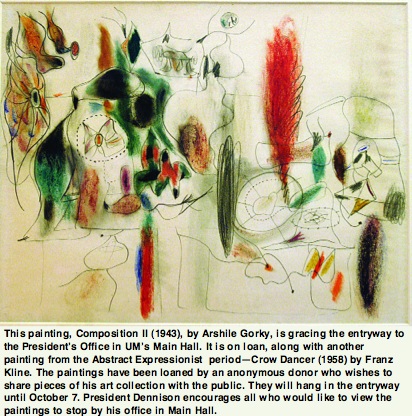 New Room for research
New Room for research
With the College of Health Professions and Biomedical Sciences growing by leaps and bounds, it is fortuitous a wealthy donor continues to support its work. L.S. “Sam” Skaggs was the chief benefactor of the college’s new building, completed in 1999 and named in his honor. This year he stepped forward one more time to contribute $3.5 million to a $14 million project that will add a wing to the building.
And so a ceremony was held in May to dedicate the Skaggs Pharmacy Building and to toast the college for its growing success in biomedical research. The nearly 60,000-square-foot addition will provide the college with space for its burgeoning research programs (see story on page 16.) It will house interdisciplinary labs, conference rooms, an electronic classroom, a kindergarten-through-twelfth-grade learning center, a tiered classroom, and student support areas. Other funding for the new addition comes from campus-based revenue bonds, the National Institutes of Health, and the Poe Family Trust.
Sam Skaggs’ ALSAM Foundation and Albertson’s have contributed a total of $11.7 million to both projects. Earlier in the year the college’s pharmacy school was renamed the Skaggs School of Pharmacy in his honor.
up close
Winner From Wilsall
The Montanan staff, with the help of many volunteers, conducted a telephone readership survey in May and learned all kinds of things (see Editor’s Desk on page 2).
We learned that Montanan readers are drawn to historical stories and also want to read more regional features and essays. Of our regular departments, participants reported reading About Alumni and Artifacts the most. Participants liked many of the story ideas we floated by them, particularly a story of the most notable alumni and faculty at UM, a story on UM’s College of Technology and its work with alternative energy, and a research story on the groundbreaking work of a UM geologist.
We learned that only a small percentage of you are accessing the Montanan on-line and that more than 41 percent of you get 75 percent or more of your information about UM from the magazine.
Another thing we learned was that Joan Knodel of Wilsall is a very lucky woman. Of several hundred readers contacted, she was the one to win the $100 gift certificate to the UM Bookstore. We promised a chance at that prize for all those who agreed to answer our questions.
Congratulations, Joan. And go ahead and spend it all in one place.
extra credit
UM No. 1 IN UDALLS
Jeffrey Ross focused his application for a Udall scholarship on two causes Morris K. Udall worked for throughout his lifetime—the environment and American Indians. Most students who apply for the awards focus on one or the other, but Ross had a different vision.
“It is my goal to integrate the two by increasing the Native American presence in the conservation and preservation movement,” Ross says. He is one of four UM students to receive Udall scholarships in 2005 and part of a record-breaking precedent. In 2005 UM passed Cornell University to become the nation’s pre-eminent institution in producing Udall scholars. A total of twenty-two UM scholars have been named since the scholarships were first awarded in 1996.
The Udall scholarship program was established by Congress in 1992 to honor Udall’s service in the U.S. House of Representatives. Each year the $5,000 scholarship awards are given to eighty college sophomores and juniors across the country who have shown dedication and extraordinary potential in pursuing environmental research and to American Indian and Alaskan Native college students who have shown exceptional potential and commitment in tribal public policy or health care careers.
In addition to Ross, other UM students who will receive scholarships for the 2005-06 school year are Zach Benson, Marcia St. Goddard, and John Powell.
Ross, a member of the Ojibwa tribe from Rivers, Manitoba, drew from his experience in working on land management policy, specifically on Native tribal lands, to win the scholarship. A Blackfeet Indian, St. Goddard of Browning was chosen for her involvement in reservation health care. Benson, a Colstrip native (featured on page 10), drew from his work in environmental water remediation science to earn his scholarship. Powell, of Muncie, Indiana, received his Udall for population genetic research he conducts on westslope cutthroat trout. He studies fish from rivers and lakes across western Montana in the conservation genetics lab at UM. – Brianne Burrowes
The President's Corner

As I walked across campus one morning this week, I encountered a local artist and University alumnus who told me that he came to campus often to enjoy the spectacular beauty and collect his thoughts. Those of us who came here as students or as faculty and staff members recognize instantly the feeling invoked by my artist friend. But the whole amounts to more than the sum of the parts. As I think about my own experiences, as a student and later as an administrator with some responsibility for sustaining the ambience, it becomes clear to me that the place and the people together create the irresistible allure and attractiveness. More than that, the place inspires people—whether students, staff, or faculty—to wonderful achievements, as attested in every issue of the Montanan, including this one.
As you enjoy this issue with its feature articles focusing on a few of our outstanding people, try to imagine them in another context. It simply does not work for me. The people and the place together create a sense of excellence, pride, and inherent beauty that characterizes The University of Montana.
I want also to take this occasion to congratulate the editor and staff of the Montanan for an award-winning year. As a recent readership survey clearly reveals, the readers agree with the judges of a national competition. [The Montanan was named Most Improved Magazine in 2005 by the Association of Educational Publishers.] In a sense, we loyal subscribers have a journal that matches the institution in which we take such pride.
With every passing year, I become increasingly convinced that we can and will maintain a University of the twenty-first century, offering an education second to none, because of the contributions of the outstanding students, staff, and faculty, and the assistance of our many friends and loyal alumni.
![]()
George M. Dennison ’62, M.A. ’63
President and professor of history
up close
New Athletic Director for the Griz
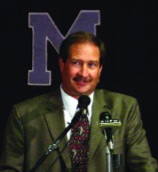 Jim O’Day was named UM’s athletic director in June. The former director of development for UM’s Intercollegiate Athletics, O’Day was chosen from a field of sixty applicants after an extensive search. He replaces Don Read, who led the athletic department during the past year.
Jim O’Day was named UM’s athletic director in June. The former director of development for UM’s Intercollegiate Athletics, O’Day was chosen from a field of sixty applicants after an extensive search. He replaces Don Read, who led the athletic department during the past year.
“We have many challenges ahead, with many peaks and valleys, but together we can climb those mountains,” O’Day said. “Together we can make Grizzly athletics one step better than it is today.”
Other finalists for the job were: Calli Sanders, senior associate athletic director at Iowa State; Tom Sadler, senior associate athletic director at the University of Hawaii; Mike Marlow, associate athletic director at the University of Oregon; and Tom Collins, senior associate athletic director at Arizona State University.
UM President George Dennison made the final decision after reviewing recommendations from the search committee. “I talked to a lot of people on and off campus,” he said, “and Jim O’Day is what the institution and department needs at this time.”
For the last five years O’Day has been director of development for UM Intercollegiate Athletics, and he was assistant director of the Grizzly Athletic Association for two years before that. He received his undergraduate journalism degree from UM, where he was sports editor of the Montana Kaimin.
A native of Cut Bank, O’Day was owner and publisher of The Western Breeze newspaper in Cut Bank before coming to UM.
alumni achiever
Honorary Doctorate
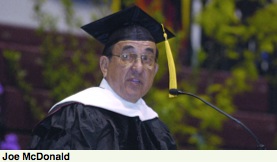 A national leader in American Indian education, Joe McDonald received UM’s highest recognition—an Honorary Doctorate of Humane Letters—during the University’s Commencement ceremonies last May. McDonald also was the commencement speaker for the 2005 graduation ceremonies.
A national leader in American Indian education, Joe McDonald received UM’s highest recognition—an Honorary Doctorate of Humane Letters—during the University’s Commencement ceremonies last May. McDonald also was the commencement speaker for the 2005 graduation ceremonies.
Founder and current president of Salish Kootenai College in Pablo, McDonald has a long history in Indian education, which has included teaching elementary and high school students, teaching and coaching at Northern Montana College, and establishing extension centers for Kalispell’s Flathead Valley Community College, which grew into Salish Kootenai College, and for Blackfeet Community College.
“Joe McDonald, more than any other person, embodies American Indian education,” says UM President George Dennison. “He provided the leadership that resulted in the designation of the tribal colleges as land grant colleges and has participated in every endeavor to assure their increasing effectiveness.”
McDonald serves as president of the American Indian Higher Education Consortium, which helps maintain standards of quality in Indian education and supports the development of tribal colleges, as well as legislation and policymaking to support Indian higher education. He also serves on the boards of the American Council on Education and the American Indian College Fund. He now holds four degrees from UM.
alumni achievers
Attorney, Writer, and Businesswoman Honored
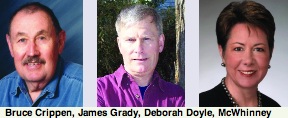 The UM Alumni Association recently announced it will honor three distinguished alumni for 2005—Bruce D. Crippen, James Grady, and Deborah Doyle McWhinney—at Homecoming, October 1.
The UM Alumni Association recently announced it will honor three distinguished alumni for 2005—Bruce D. Crippen, James Grady, and Deborah Doyle McWhinney—at Homecoming, October 1.
A Billings attorney, Bruce Crippen, is the only senator from Yellowstone County to be named president of the Montana State Senate and serve as minority whip, minority leader, and president pro-tempore. He received his bachelor’s degree in accounting in 1956 and a juris doctorate in 1959. Crippen is an emeritus member of the UM Foundation Board of Trustees. In 1995 he received the Neil S. Bucklew Presidential Service Award at Charter Day. Crippen developed Rimrock Mall in Billings. He has served as chair of the Public Service Board of Billings, on the board of directors of the Billings Yellowstone Art Center and the YMCA, as president of Yellowstone County United Way, and as adviser of Eagle Mount. He and his wife, Mary, have four children.
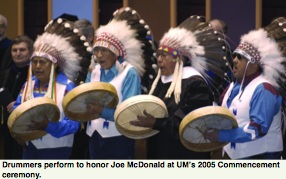 A staff aide for the 1972 Montana Constitutional Convention, James Grady ’72 launched his writing career at the age of twenty-four with his novel Six Days of the Condor—later made into the movie Three Days of the Condor. Jim served as an aide to Montana Senator Lee Metcalf and then worked for four years for the nationally syndicated columnist Jack Anderson. He has published thirteen novels and many short stories. Grady’s writing is well known in Europe, where he has received French and Italian literary awards. His film and television credits include cable feature movie scripts, episodes for a dramatic series, original screenplays, and consulting for CBS Movie of the Week. This Shelby native and graduate of UM’s journalism school lives in Silver Spring, Maryland, with his wife, Bonnie. They have two children.
A staff aide for the 1972 Montana Constitutional Convention, James Grady ’72 launched his writing career at the age of twenty-four with his novel Six Days of the Condor—later made into the movie Three Days of the Condor. Jim served as an aide to Montana Senator Lee Metcalf and then worked for four years for the nationally syndicated columnist Jack Anderson. He has published thirteen novels and many short stories. Grady’s writing is well known in Europe, where he has received French and Italian literary awards. His film and television credits include cable feature movie scripts, episodes for a dramatic series, original screenplays, and consulting for CBS Movie of the Week. This Shelby native and graduate of UM’s journalism school lives in Silver Spring, Maryland, with his wife, Bonnie. They have two children.
Deborah McWhinney currently lives in Tiburon, California, where she is president of Schwab Institutional at Charles Schwab & Company Inc. She is executive adviser to the Hitachi HDS and Hitachi Limited board and executive team and is on the board of directors of the Securities Investor Protection Corporation. A Missoula native, McWhinney is past president of UM’s Foundation Board of Directors and an emeritus member of UM’s Business Advisory Council and the UMAA Board of Trustees. She was listed as one of the 100 Most Influential Women in Bay Area Business by the San Francisco Business Times in April 2005. McWhinney graduated in 1977 with a bachelor’s degree in communications. She is the mother of two daughters.
candid campus
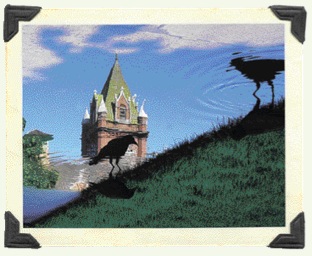 With this photo, we begin a regular Oval section. Knowing our readers can’t get enough of campus views and inspired by our President’s letter describing the lure of UM’s campus, we decided to run a photo each issue that features UM and/or its people. We are looking for recently-taken photos that are either striking visually or tell a story of some sort. They should not be posed in any way. This photo, taken by UM student April Blankenship, actually was a shot of the reflection of Main Hall and crows in a pool of water. If you turn the photo 180 degrees you’ll see the original view.
With this photo, we begin a regular Oval section. Knowing our readers can’t get enough of campus views and inspired by our President’s letter describing the lure of UM’s campus, we decided to run a photo each issue that features UM and/or its people. We are looking for recently-taken photos that are either striking visually or tell a story of some sort. They should not be posed in any way. This photo, taken by UM student April Blankenship, actually was a shot of the reflection of Main Hall and crows in a pool of water. If you turn the photo 180 degrees you’ll see the original view.
griz greats
To the Highest Bidder
 Grizzlies have been prowling Missoula streets for some time now. But soon they’ll be gathered together and auctioned off to the highest bidder. It’s all part of the Montana Grizzly Scholarship Association’s fundraiser, the Grizzly Prowl.
Grizzlies have been prowling Missoula streets for some time now. But soon they’ll be gathered together and auctioned off to the highest bidder. It’s all part of the Montana Grizzly Scholarship Association’s fundraiser, the Grizzly Prowl.
It began last year when thirty-five artists throughout the state were chosen to make art of life-size fiberglass grizzly molds, a take-off on the “Cows on Parade” concept that originated in Chicago in 1999. The artists used the forms as a canvas to depict western scenes, and various themes, venues, and activities. There’s a golfing bear, a cyborg-like bear, a bear that displays the University campus a century ago, a bear that embodies a Grizzly football team, a bear with salmon swimming through its bloodstream, and a bear that boasts elements of a Charlie Russell painting, to describe a few.
The bears have been on display at a variety of public venues in Missoula and Hamilton for several months. The auction, which will include a dinner and dance, will be held September 16 at the University Center. Those attending will not be the only ones able to bid on the bears. C.J. Merrill, the project’s coordinator, reports that people across the country can view all of the bears on the Internet at http://www.grizzlyprowl.com and contact the GSA office at (406) 243-6487 if they are interested in bidding on a bear. Merrill reports the association has a list of locations that are willing to display a bear as public art if the owner would prefer to leave the bear in a public place or doesn’t have room to display the work.
extra credit
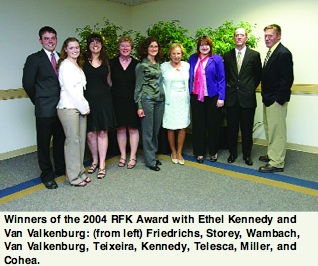 UM J-School Honored with ‘Poor People’s Pulitzer’
UM journalists found themselves in good company in May when they received the Robert F. Kennedy Journalism Award at George Washington University in Washington, D.C. Among those they rubbed elbows with were Bob Woodward, Ethel Kennedy, Arthur Schlesinger Jr., Art Buchwald, and Harry Belafonte.
UM J-School Honored with ‘Poor People’s Pulitzer’
UM journalists found themselves in good company in May when they received the Robert F. Kennedy Journalism Award at George Washington University in Washington, D.C. Among those they rubbed elbows with were Bob Woodward, Ethel Kennedy, Arthur Schlesinger Jr., Art Buchwald, and Harry Belafonte.
Journalism professors Carol Van Valkenburg and Teresa Tamura were on hand to receive the award, along with seven of the fourteen students in UM’s 2004 Native News Honors Project. The group won for reporting in Sovereignty, a thirty-six page, in-depth look into the struggle of tribal communities in Montana to regain control over the welfare and future of their people.
“This is a wonderful tribute to the excellent work produced by our students,” VanValkenburg says. “It is also significant because it honors those many, many people on Montana’s reservations who for years have opened up their lives and their homes to our students so that their stories could be told.”
The RFK Journalism Awards were founded in 1968 by a group of journalists who covered Senator Kennedy’s presidential campaign. The award cites outstanding reporting on the poor and disadvantaged and is called the “poor people’s Pulitzer.”
UM students contributing to the project were Jessica Wambach, Adam Weinacker, Alisha Wyman, Fred Miller, Natalie Storey, Sadie Craig, Joe Friedrichs, Meghan Brown, Adam Bystrom, Mike Cohea, Lisa Hornstein, Chandler Melton, Noelle Teixeira, and Heather Telesca.
The following is an excerpt from a story written about the experience by one of the recipients, Joe Friedrichs, now a reporter for the Curry Coastal Pilot in Brookings, Oregon. The story originally appeared on the journalism school’s Web site; it also ran in the Pilot.
When we arrived at GWU, I entered the room with equal parts of pride and fear. Top-notch journalists were mingling everywhere. The five of us stood against the wall of the winner’s room like potential convicts in a police line-up. I finally mustered the nerve to mingle and start a conversation.I ended up talking with fellow RFK award winner Mark Fiore. His editorial cartoons won this year, and the conversation was easy and smooth.
All eyes were on Ethel Kennedy when she walked in. She was beautiful—elegant and graceful. After a few moments, we walked over and had our picture taken with her. I gave her a hug. She smelled like heaven. Everything was suddenly happening before our eyes. ...
Our award was the second to be announced, and [we] glided to the stage. There, Ethel Kennedy shook our hands and gave us a ten-pound bust of Robert Kennedy. The few moments between hearing our names called, the loud applause and walking to and from the stage are a bit of a haze.
All of the other awards were handed out, including the 2005 Lifetime Achievement Award to Arthur Schlesinger Jr. The famed U.S. historian and author is in the twilight of his career. His frame is worn by the years. His voice is soft and choppy. But his mind is sharp. ...
Bob Woodward, of the famed Watergate investigative pieces, stood near the door for a while, watching the past and present of the journalism community. When he shot a glance in my direction, I realized he was watching the future. ...
We took the bust of Robert Kennedy and headed back in the direction of the Marriott. I stopped three beautiful women in the street and explained to them who I was and why I was holding this bust of Kennedy. One of them touched my arm. I continued my strut. Later, Miller, Cohea and I enjoyed the nightlife in Georgetown—until 4 a.m.
Our phone rang just a few hours later. It was Van Valkenburg. “This is your fairy godmother,” she hollered into the phone. “Get out of bed, we’re going to the Post.”
The three of us rolled out of bed and tried to pack our bags. Basically, we stuffed everything into them with no order whatsoever. My bag ended up looking like a deformed egg.
Nancy Szokan, 2004 Pollner Professor at UM and Post editor, had arranged to meet us for lunch and give us a tour of the paper. ... It made me realize how quickly the wheels are turning. One weekend I graduated from college. The next, I was sitting in the Washington Post having lunch with some of its editors and reporters. What a wonderful world.
During the meal, Szokan pointed out a man sitting at the table next to us. It was former Post Editor Ben Bradlee. ...After lunch Szokan let us sit in on the budget meeting of the Post editorial staff. This is where they decide what goes on the next day’s paper, especially the front page. There we sat, four fresh UM grads and one professor, watching the staff of one of the most powerful newspapers in the world conduct its business. The meeting was quick and efficient.
It made me hungry for the big time. It made me hungry to start my career.
discovery
Chick-A-Dee-Dee-Dee
 The headline for this story is actually quite alarming—at least to a chick-a-dee. UM researchers have discovered a previously unknown level of sophistication in the calls of the birds. Basically, the more dangerous a predator is to a chickadee, the more “dee” sounds the birds tack onto the end of their trademark “chick-a-dee” call.
The headline for this story is actually quite alarming—at least to a chick-a-dee. UM researchers have discovered a previously unknown level of sophistication in the calls of the birds. Basically, the more dangerous a predator is to a chickadee, the more “dee” sounds the birds tack onto the end of their trademark “chick-a-dee” call.
This discovery by Erick Greene, a UM professor of biological sciences, and his former graduate student Chris Templeton was notable enough to be featured in a recent issue of Science. The story has since made the New York Times, the Washington Post, and other news outlets worldwide.
Greene is a behavioral ecologist and acting associate dean of the Division of Biological Sciences. Templeton is now a doctoral student at the University of Washington. The two found that common chickadees have a complex system of alarm calls that convey information about the size and danger of potential predators and tell the birds what sort of defense to mount in response.
Greene and Templeton conducted their experiments in aviary pens at UM’s research Field Station at Fort Missoula. To captured flocks of black-capped chickadees they showed thirteen types of flying predators—everything from hawks and falcons to five-inch-tall pygmy owls. They also exposed the chickadees to cats and ferrets, as well as harmless bobwhites.
Research showed that a massive great horned owl only elicited two “dee” syllables at the end of a call because the quick chickadees can easily outmaneuver it. But the sight of a lightning-quick pygmy owl sent the chickadees into a frenzy—eliciting four “dees” at the end of their calls.
Contrary to what people might believe, Greene says, the chickadees were far less concerned by the bigger hunters. But a smaller raptor with a short turning radius drove them nuts, as well as a ferret or cat.
![]()
![]()